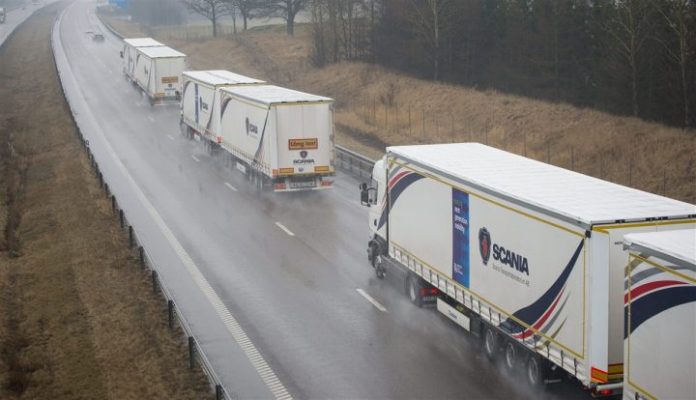Truck platooning is gaining traction with some ongoing trials in Europe and the United States
Truck platooning involves a number of trucks equipped with state-of-the-art driving support systems. The vehicles move in a group or platoon with the trucks driven by smart technology and communicating with one another. Truck platooning offers potential innovation for the transport sector globally.
Grouping vehicles into platoons is a method of increasing the capacity of roads. Platoons decrease the distances between cars or trucks using electronic, and possibly mechanical, coupling. This capability can allow many cars or trucks to accelerate or brake simultaneously. Vehicles can follow each other more closely than with human drivers, because less reaction distance is needed than human drivers require.
With the trucks braking immediately, with near-zero reaction time, platooning can also improve traffic safety. Platooning is also a cost-saver as the trucks drive close together at a constant speed. This means lower fuel consumption and fewer carbon dioxide emissions. According to European Truck Platooning, platooning efficiently boosts traffic flows thereby reducing tail-backs.
The impact of truck platooning goes far beyond the transport sector. Automated driving and smart mobility also offer realistic chances to optimize the labor market, logistics and industry, the European entity said.
Governments, entities and companies in the United States and Europe are already active in the truck platooning field.
Last year, the U.K. government confirmed that it has allocated £8.1 million ($11 million) to carry out track platooning trials. Officials explained that the platooning trials will see up to three trucks traveling in convoy with acceleration and braking controlled by the lead vehicle. All trucks in the platoon will always have a driver ready to take control at any time.
The Transport Research Laboratory (TRL) will carry out the truck platooning trial, with funding provided by the Department for Transport and Highways England. The initiative follows a government-funded feasibility study which recommended a trial to examine the benefits and viability of platooning.
The trial will be carried out in three phases, with the first focusing on the potential for truck platooning on the UK’s major roads. The initial research will help decide details such as distance between vehicles and on which roads the tests could take place.
Trials are expected on major roads by the end of 2018. Each phase of the testing will only begin when there is robust evidence that it can be done safely, the U.K government said.
In the U.S, local automated vehicles solutions provider Peloton has been engaged in trials to show the benefits of truck platooning. In December 2017, Peloton conducted a live demonstration of driver-assistive truck platooning in Michigan.
The company said the demo featured a pair of Peloton-equipped Volvo VNL670 class 8 trucks platooning with separation of approximately 65 feet, allowing participants to experience how this semi-automated and connected vehicle technology, including vehicle-to-vehicle (V2V) communications, assists drivers in a real-world setting.
The company also carried out a similar demonstration in Florida in January this year.
Peloton’s two-truck system enables pairs of trucks to coordinate their speeds and maintain a safe following distance. The Peloton system limits platooning to appropriate multi-lane, divided, limited access highways. The system also orders pairs of trucks and determines their optimal following distance and enables the rear truck in a platoon to respond to braking by the lead truck in approximately a tenth of a second, eliminating the normal delay from driver perception and reaction time, the company said.
Peloton said these demonstrations represented a key step towards commercial deployment of the Peloton platooning system, which is expected to occur by the end of this year. The company said it has already signed truck platooning deals with a number of fleets in North America.

